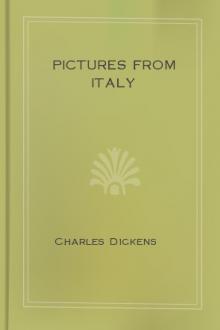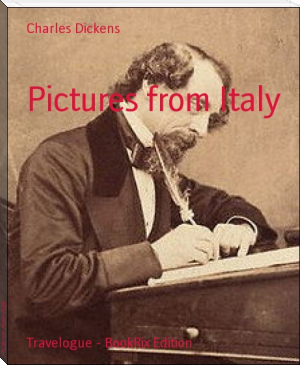Pictures From Italy, Charles Dickens [popular books of all time .txt] 📗

- Author: Charles Dickens
- Performer: -
Book online «Pictures From Italy, Charles Dickens [popular books of all time .txt] 📗». Author Charles Dickens
The geese who saved the Capitol, were, as compared to these, Pork to the learned Pig. What a gallery it was! I would take their opinion on a question of art, in preference to the discourses of Sir Joshua Reynolds.
Now that we were standing in the street, after being thus ignominiouly escorted thither, my little friend was plainly reduced to the ‘piccolo giro,’ or little circuit of the town, he had formerly proposed. But my suggestion that we should visit the Palazzo Te (of which I had heard a great deal, as a strange wild place) imparted new life to him, and away we went.
The secret of the length of Midas’s ears, would have been more extensively known, if that servant of his, who whispered it to the reeds, had lived in Mantua, where there are reeds and rushes enough to have published it to all the world. The Palazzo Te stands in a swamp, among this sort of vegetation; and is, indeed, as singular a place as I ever saw.
Not for its dreariness, though it is very dreary. Not for its dampness, though it is very damp. Nor for its desolate condition, though it is as desolate and neglected as house can be. But chiefly for the unaccountable nightmares with which its interior has been decorated (among other subjects of more delicate execution), by Giulio Romano. There is a leering Giant over a certain chimney-piece, and there are dozens of Giants (Titans warring with Jove) on the walls of another room, so inconceivably ugly and grotesque, that it is marvellous how any man can have imagined such creatures. In the chamber in which they abound, these monsters, with swollen faces and cracked cheeks, and every kind of distortion of look and limb, are depicted as staggering under the weight of falling buildings, and being overwhelmed in the ruins; upheaving masses of rock, and burying themselves beneath; vainly striving to sustain the pillars of heavy roofs that topple down upon their heads; and, in a word, undergoing and doing every kind of mad and demoniacal destruction. The figures are immensely large, and exaggerated to the utmost pitch of uncouthness; the colouring is harsh and disagreeable; and the whole effect more like (I should imagine) a violent rush of blood to the head of the spectator, than any real picture set before him by the hand of an artist. This apoplectic performance was shown by a sickly-looking woman, whose appearance was referable, I dare say, to the bad air of the marshes; but it was difficult to help feeling as if she were too much haunted by the Giants, and they were frightening her to death, all alone in that exhausted cistern of a Palace, among the reeds and rushes, with the mists hovering about outside, and stalking round and round it continually.
Our walk through Mantua showed us, in almost every street, some suppressed church: now used for a warehouse, now for nothing at all: all as crazy and dismantled as they could be, short of tumbling down bodily. The marshy town was so intensely dull and flat, that the dirt upon it seemed not to have come there in the ordinary course, but to have settled and mantled on its surface as on standing water. And yet there were some business-dealings going on, and some profits realising; for there were arcades full of Jews, where those extraordinary people were sitting outside their shops, contemplating their stores of stuffs, and woollens, and bright handkerchiefs, and trinkets: and looking, in all respects, as wary and business-like, as their brethren in Houndsditch, London.
Having selected a Vetturino from among the neighbouring Christians, who agreed to carry us to Milan in two days and a half, and to start, next morning, as soon as the gates were opened, I returned to the Golden Lion, and dined luxuriously in my own room, in a narrow passage between two bedsteads: confronted by a smoky fire, and backed up by a chest of drawers. At six o’clock next morning, we were jingling in the dark through the wet cold mist that enshrouded the town; and, before noon, the driver (a native of Mantua, and sixty years of age or thereabouts) began TO ASK THE WAY
to Milan.
It lay through Bozzolo; formerly a little republic, and now one of the most deserted and poverty-stricken of towns: where the landlord of the miserable inn (God bless him! it was his weekly custom) was distributing infinitesimal coins among a clamorous herd of women and children, whose rags were fluttering in the wind and rain outside his door, where they were gathered to receive his charity. It lay through mist, and mud, and rain, and vines trained low upon the ground, all that day and the next; the first sleeping-place being Cremona, memorable for its dark brick churches, and immensely high tower, the Torrazzo—to say nothing of its violins, of which it certainly produces none in these degenerate days; and the second, Lodi. Then we went on, through more mud, mist, and rain, and marshy ground: and through such a fog, as Englishmen, strong in the faith of their own grievances, are apt to believe is nowhere to be found but in their own country, until we entered the paved streets of Milan.
The fog was so dense here, that the spire of the far-famed Cathedral might as well have been at Bombay, for anything that could be seen of it at that time. But as we halted to refresh, for a few days then, and returned to Milan again next summer, I had ample opportunities of seeing the glorious structure in all its majesty and beauty.
All Christian homage to the saint who lies within it! There are many good and true saints in the calendar, but San Carlo Borromeo has—if I may quote Mrs. Primrose on such a subject—‘my warm heart.’ A charitable doctor to the sick, a munificent friend to the poor, and this, not in any spirit of blind bigotry, but as the bold opponent of enormous abuses in the Romish church, I honour his memory. I honour it none the less, because he was nearly slain by a priest, suborned, by priests, to murder him at the altar: in acknowledgment of his endeavours to reform a false and hypocritical brotherhood of monks. Heaven shield all imitators of San Carlo Borromeo as it shielded him! A reforming Pope would need a little shielding, even now.
The subterranean chapel in which the body of San Carlo Borromeo is preserved, presents as striking and as ghastly a contrast, perhaps, as any place can show. The tapers which are lighted down there, flash and gleam on alti-rilievi in gold and silver, delicately wrought by skilful hands, and representing the principal events in the life of the saint. Jewels, and precious metals, shine and sparkle on every side. A windlass slowly removes the front of the altar; and, within it, in a gorgeous shrine of gold and silver, is seen, through alabaster, the shrivelled mummy of a man: the pontifical robes with which it is adorned, radiant with diamonds, emeralds, rubies: every costly and magnificent gem. The shrunken heap of poor earth in the midst of this great glitter, is more pitiful than if it lay upon a dunghill. There is not a ray of imprisoned light in all the flash and fire of jewels, but seems to mock the dusty holes where eyes were, once. Every thread of silk in the rich vestments seems only a provision from the worms that spin, for the behoof of worms that propagate in sepulchres.
In the old refectory of the dilapidated Convent of Santa Maria delle Grazie, is the work of art, perhaps, better known than any other in the world: the Last Supper, by Leonardo da Vinci—with a door cut through it by the intelligent Dominican friars, to facilitate their operations at dinner-time.
I am not mechanically acquainted with the art of painting, and have no other means of judging of a picture than as I see it resembling and refining upon nature, and presenting graceful combinations of forms and colours. I am, therefore, no authority whatever, in reference to the ‘touch’ of this or that master; though I know very well (as anybody may, who chooses to think about the matter) that few very great masters can possibly have painted, in the compass of their lives, one-half of the pictures that bear their names, and that are recognised by many aspirants to a reputation for taste, as undoubted originals. But this, by the way. Of the Last Supper, I would simply observe, that in its beautiful composition and arrangement, there it is, at Milan, a wonderful picture; and that, in its original colouring, or in its original expression of any single face or feature, there it is not. Apart from the damage it has sustained from damp, decay, or neglect, it has been (as Barry shows) so retouched upon, and repainted, and that so clumsily, that many of the heads are, now, positive deformities, with patches of paint and plaster sticking upon them like wens, and utterly distorting the expression. Where the original artist set that impress of his genius on a face, which, almost in a line or touch, separated him from meaner painters and made him what he was, succeeding bunglers, filling up, or painting across seams and cracks, have been quite unable to imitate his hand; and putting in some scowls, or frowns, or wrinkles, of their own, have blotched and spoiled the work. This is so well established as an historical fact, that I should not repeat it, at the risk of being tedious, but for having observed an English gentleman before the picture, who was at great pains to fall into what I may describe as mild convulsions, at certain minute details of expression which are not left in it. Whereas, it would be comfortable and rational for travellers and critics to arrive at a general understanding that it cannot fail to have been a work of extraordinary merit, once: when, with so few of its original beauties remaining, the grandeur of the general design is yet sufficient to sustain it, as a piece replete with interest and dignity.
We achieved the other sights of Milan, in due course, and a fine city it is, though not so unmistakably Italian as to possess the characteristic qualities of many towns far less important in themselves. The Corso, where the Milanese gentry ride up and down in carriages, and rather than not do which, they would half starve themselves at home, is a most noble public promenade, shaded by long avenues of trees. In the splendid theatre of La Scala, there was a ballet of action performed after the opera, under the title of Prometheus: in the beginning of which, some hundred or two of men and women represented our mortal race before the refinements of the arts and sciences, and loves and graces, came on earth to soften them. I never saw anything more effective. Generally speaking, the pantomimic action of the Italians is more remarkable for its sudden and impetuous character than for its delicate expression, but, in this case, the drooping monotony: the weary, miserable, listless, moping





Comments (0)